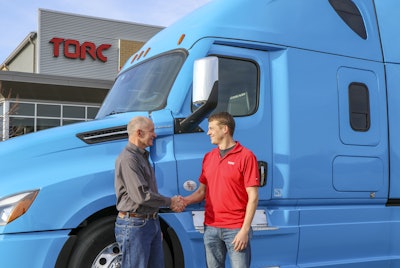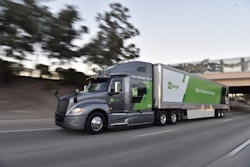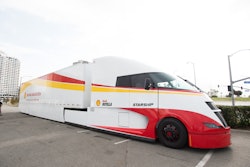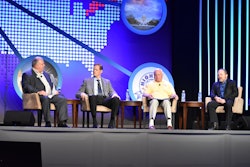 DTNA’s Roger Nielsen and Torc Robotics’ Michael Fleming announce the companies’ partnership to develop SAE Level 4 self-driving technology within a decade.
DTNA’s Roger Nielsen and Torc Robotics’ Michael Fleming announce the companies’ partnership to develop SAE Level 4 self-driving technology within a decade.Daimler Trucks and Buses, parent company of Daimler Trucks North America, has taken another step toward its goal of delivering commercially viable self-driving trucks by acquiring a majority stake in Torc Robotics, a Blacksburg, Va.-based autonomous driving solutions provider and developer of the Asimov self-driving software.
Daimler Trucks and Buses CEO Martin Daum said that the company will continue to leverage the automated technology from Daimler’s passenger car division, but the vehicle physics and application demands in heavy-duty trucking require unique autonomous development to reach its 10-year goal of delivering SAE Level 4 trucks that initially will be deployed in hub-to-hub operations along U.S. highways.
“Bringing Torc Robotics within the Daimler Trucks family creates a unique and powerful team of innovators to put highly automated trucks on the road,” said Daum. “Daimler Trucks and Torc Robotics complement each other perfectly in terms of resources, expertise, and skill sets. We are forming the ideal combination between Torc’s expertise on agile software development and our experience in delivering reliable and safe truck hardware.”
“We believe the fastest and most efficient way to commercialize this revolutionary technology is to partner with OEMs,” said Michael Fleming, CEO and co-founder of Torc Robotics. “By partnering with world’s largest truck manufacturer, we are going to save even more lives with self-driving trucks.”
SAE Level 4 autonomy still requires the need for a driver, but the system’s ability to safely bring the truck to a stop in the event of an emergency without intervention can help redefine the role of the driver.
“Drivers do more than steer and drive, they are the customer service agents for the carriers,” said Roger Nielsen, DTNA CEO, adding SAE Level 4 will “make their path between the shipping dock and receiving dock safer, more convenient and more productive.”
Nielsen said the partnership is a natural extension of the SAE Level 2 and that the Level 4 technology DTNA and Torc develops will address business cases in North America, particularly with the growth of e-commerce.
“Our customers are facing serious problems with personnel – recruiting, training and retaining driers are all top 10 concerns,” said Nielsen. SAE Level 4 “will make driving job more attractive so they can have higher employment levels.”
Torc will work with DTNA to develop software and system technology at the company’s Automated Truck Research & Development Center in Portland, Ore., while the OEM will continue vehicle hardware “perfectly suited for automated driving, particularly the redundancy of systems needed to provide the maximum level of reliability and safety.”
Daimler’s roadmap for autonomous development began in 2014 with the introduction of the Mercedes-Future Truck 2025 concept truck in Europe. In 2015, DTNA unveiled the Freightliner Cascadia Inspiration truck, the precursor to the 2020 Freightliner Cascadia that will be available with SAE Level 2 partially automated driving features later this year. Daum said SAE Level 4 technology will require a couple years of development before the company can pinpoint a timeline for commercially viable adoption.
“Partially automated systems provide optimal support for the driver,” said Daum. “We have already achieved a lot with this technology. Still, partially automated driving is an intermediate goal for us. Within a decade we expect to put highly automated level 4 truck in production and on the road.”












